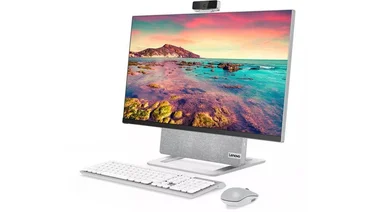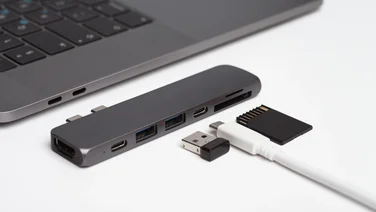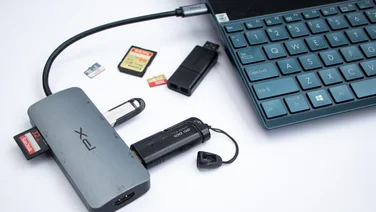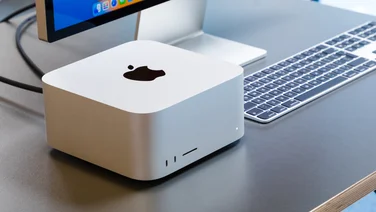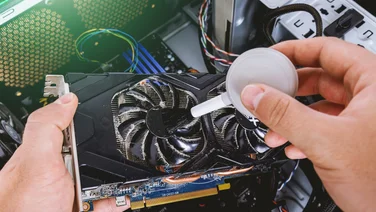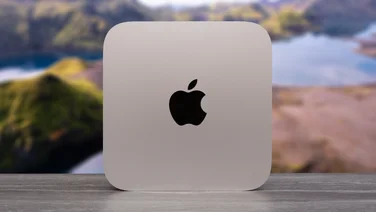To help us provide you with free impartial advice, we may earn a commission if you buy through links on our site. Learn more







- Very respectable graphics card
- Plenty of room for upgrades
- HIgh storage capacity
- Shabby CPU performance
- Storage format is outdated
This PC is something specifically for the gaming crowd: it has, on paper, the most powerful budget GPU of its generation, Nvidia’s full-fat 6GB GeForce GTX 1060. There was a time not long ago when you could have expected to pay around £1,000 for a GTX 1060 desktop, and while it has since been superseded by the RTX 2060, it’s still the most capable card that could realistically feature in a £700 pre-build.
READ NEXT: Overclockers Gaming XVI Essential review
Overclockers Gaming Vision VR review: Graphics performance
Sure enough, if it’s gaming prowess you want, the Gaming Vision VR is far from a slouch in the Metro: Last Light Redux and SteamVR Performance Test benchmarks. In Metro, 1,920 x 1,080 is a low enough resolution to allow for 52fps without any reduction in the settings, and even at 2,560 x 1,440 – the bane of GPUs such as the GTX 1050 Ti and Radeon RX 570 – it managed to scrape 30fps. That’s playable, but the Gaming Vision VR can do better, and by dropping to High quality and disabling SSAA we got a velvety 76fps.







In comparison, the next best finisher – PC Specialist’s Apollo S2 – could only get up to 70fps with the same settings, while the Palicomp AMD Abyss and Cyberpower Ultra 5 RX both hit 62fps. The Gaming Vision VR is also (not surprisingly, given the name) the best here for virtual reality, scoring 8.5 in SteamVR, which is 1.1 above the Apollo S2.
However, these tests are, as you’d expect, almost entirely reliant on the power of the GPU. When faced with a game that leans heavily on CPU speed as well, namely Dirt: Showdown, the Gaming Vision VR doesn’t seem so superlative. Despite its graphics card, it only managed 99fps at 1,920 x 1,080 and 92fps at 2,560 x 1,440, the latter being only one or two frames higher than that of the Apollo S2 and Ultra 5 RX, and the former being quite a bit lower.







Some bottlenecking is clearly going on, at least at 1,920 x 1,080, and fingers can only be pointed at the Intel Core i3-8100 processor. Yes, this PC may have the best GPU of the lot, but it also has the weakest processor, and such a limitation will have an adverse impact on certain games, depending on how they take advantage of your PC’s hardware.
Overclockers Gaming Vision VR review: Multitasking performance
For an idea of how the Core i3-8100 stacks up to what else you could have in a £700 PC, consider that in our 4K benchmark tests, it scored 104 in the image test, 109 in the video test, 104 in the multitasking test and 106 overall. In other words, it has significantly lower single-core heft than even the Acer Nitro N50-600, but it’s multicore loads where the Gaming Vision VR really loses out. Almost all of the AMD Ryzen-powered PCs we’ve tested, save for the Ultra 5 RX, have more than doubled its scores in the multitasking and video-encoding tests.
READ NEXT: Palicomp i5 Cosmos review
Overclockers Gaming Vision VR review: Specifications







An overall score of 106 would still be enough to tick along in basic tasks, but there’s another problem. There’s no SSD storage here, just a 1TB hard disk, something most of other PCs have relegated to backup storage. In fairness, it’s fast for a mechanical drive – AS SSD measured a 194.7MB/s read speed and a 143.9MB/s write speed – but that’s still noticeably slower than a cheap SATA SSD. The result is that the Gaming Vision VR is tangibly slower at booting Windows and loading applications, making it less appealing as an everyday system.
Luckily, the graphics card isn’t the only strong point. Inside is a full-size ATX motherboard with the high-end Intel Z370 chipset, so internal upgradability is a step up from the most rivals. There are multiple PCI-E x16 and PCI-E x1 slots going spare, along with three empty RAM slots, an M.2 slot, two 2.5in mounts and a 3.5in drive tray (there are two of these in total; one is occupied by the hard disk).
Overclockers Gaming Vision VR review: Features
Crucially, the motherboard opens up opportunities to fix the Gaming Vision VR’s weaknesses. The M.2 slot could hold an Intel Optane Memory drive, for instance, instantly boosting hard disk read speeds to SSD levels, and because the Z370 chipset enables overclocking, you could eventually replace the Core i3-8100 with an unlocked mid-range processor such as the Core i5-8600K and crank up clock speeds to high-end performance levels at a lower cost.
External connectivity is also decent, if lacking in standout features. There are two USB ports on the front – one USB 2 and one USB 3 – plus two USB 2 ports and four USB 3 ports on the back. Two PS/2 sockets, a Gigabit Ethernet port and three 3.5mm audio jacks join them on the motherboard I/O panel, while the graphics card provides a versatile combination of one HDMI port, three DisplayPort outputs and a DVI-D socket.
Overclockers Gaming Vision VR review: Verdict







There’s plenty of potential here, which is a great thing to have in a desktop. Still, as for what comes in the box, the Gaming Vision VR’s (often only situational) advantage in games isn’t enough to place it among the best.
The Apollo S2 is only slightly less capable in games, owing to it having the 3GB version of the GTX 1060, and it has a much less limiting processor in its Ryzen 5 2600. The AMD Abyss also delivers similar flexibility through its ATX motherboard (except for the lack of overclocking support), and has much better storage, too. As it stands, the only reason to buy this PC is if you want the very specific benefit of higher VR performance.
